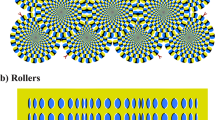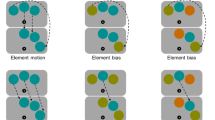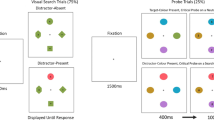Abstract
Visual attention enables an observer to select specific visual information for processing. In an ambiguous motion task in which a coloured grating can be perceived as moving in either of two opposite directions depending on the relative salience of two colours in the display, attending to one of the colours influences the direction in which the grating appears to move1. Here, we use this secondary effect of attention in a motion task to measure the effect of attending to a specific colour in a search task. Observers performed a search task in which they searched for a target letter in a 4 × 4 coloured matrix. Each of the 16 squares within a matrix was assigned one of four colours, and observers knew that the target letter would appear on only one of these colours throughout the experiment. Observers performed the ambiguous motion task before and after the search task. Attending to a particular colour for a brief period in the search task profoundly influenced the perceived direction of motion. This effect lasted for up to one month and in some cases had to be reversed by practising searches for the complementary colour, indicating a much longer-persisting effect of attention than has been observed previously.


Similar content being viewed by others
References
Blaser, E., Sperling, G. & Lu, Z.-L. Measuring the amplification of attention. Proc. Natl Acad. Sci. USA 96, 11681–11686 (1999)
Lu, Z.-L. & Sperling, G. The functional architecture of human visual motion perception. Vision Res. 35, 2697–2722 (1995)
McCollough, C. Color adaptation of edge-detectors in the human visual system. Science 149, 1115–1116 (1965)
Holland, H. C. The Spiral After-Effect (Pergamon, Oxford, 1965)
Blakemore, C. & Campell, F. W. Adaptation to spatial stimuli. J. Physiol. (Lond.) 1, 11–13 (1969)
Gilinsky, A. S. Orientation-specific effects of patterns of adapting light on visual acuity. J. Opt. Soc. Am. 58, 13–18 (1968)
Wolfe, J. M. & O'Connell, K. M. Fatigue and structural change: Two consequences of visual pattern adaptation. Investigative Ophthalmol. Vis. Sci. 27, 538–543 (1986)
Jones, P. D. & Holdings, D. H. Extremely long-term persistence of the McCollough effect. J. Exp. Psychol. 1, 323–327 (1975)
Masland, R. H. Visual motion perception: Experimental modification. Science 165, 819–821 (1969)
Blakemore, C., Nachmias, J. & Sutton, P. The perceived spatial frequency shift: Evidence for frequency-selective neurons in the human brain. J. Physiol. (Lond.) 210, 727–750 (1970)
Kalfin, K. & Locke, S. Evaluation of long term visual motion after-image following monocular stimulation. Vision Res. 12, 359–361 (1972)
Heggelund, P. & Krekling, S. Long-term retention of the Gilinsky-Effect. Vision Res. 16, 1015–1017 (1976)
Favreau, O. E. Persistence of simple and contingent motion aftereffects. Percept. Psychophys. 26, 187–194 (1979)
Neitz, J., Carroll, J., Yamauchi, Y., Neitz, M. & Williams, D. R. Color perception is mediated by a plastic neural mechanism that is adjustable in adults. Neuron 35, 783–792 (2002)
Karni, A. & Sagi, D. The time course of learning a visual skill. Nature 365, 250–252 (1993)
Fahle, M., Edelman, S. & Poggio, T. Fast perceptual learning in hyperacuity. Vision Res. 35, 3003–3013 (1995)
Ramachandran, V. S. & Braddick, O. Orientation-specific learning in stereopsis. Perception 2, 371–376 (1973)
McKee, S. P. & Westheimer, G. Improvement in vernier acuity with practice. Percept. Psychophys. 24, 258–262 (1978)
Fiorentini, A. & Berardi, N. Perceptual learning specific for orientation and spatial frequency. Nature 287, 43–44 (1980)
Ball, K. & Sekuler, R. A specific and enduring improvement in visual motion discrimination. Science 218, 697–698 (1982)
Poggio, T., Fahel, M. & Edelman, S. Fast perceptual learning in visual hyperacuity. Science 256, 1018–1021 (1992)
Karni, A. & Sagi, D. Where practice makes perfect in texture discrimination: evidence for primary visual cortex plasticity. Proc. Natl Acad. Sci. USA 88, 4966–4970 (1991)
Derrington, A. M., Krauskopf, J. & Lennie, P. Chromatic mechanisms in lateral geniculate nucleus of Macaque. J. Physiol. 357, 241–265 (1984)
Anstis, S. & Cavanagh, P. in Color Vision (eds Mollon, J. D. & Sharpe, E. T.) 155–166 (Academic, New York, 1983)
Lu, Z.-L. & Sperling, G. Sensitive calibration and measurement procedures based on the amplification principle in motion perception. Vision Res. 41, 2355–2374 (2001)
Acknowledgements
This research was supported by AFOSR, Life Science Directorate, Visual Information Processing Program.
Author information
Authors and Affiliations
Corresponding authors
Ethics declarations
Competing interests
The authors declare that they have no competing financial interests.
Rights and permissions
About this article
Cite this article
Tseng, Ch., Gobell, J. & Sperling, G. Long-lasting sensitization to a given colour after visual search. Nature 428, 657–660 (2004). https://doi.org/10.1038/nature02443
Received:
Accepted:
Issue Date:
DOI: https://doi.org/10.1038/nature02443
- Springer Nature Limited
This article is cited by
-
Contribution of the slow motion mechanism to global motion revealed by an MAE technique
Scientific Reports (2021)





